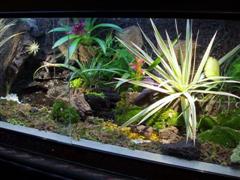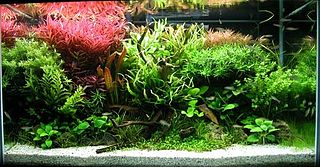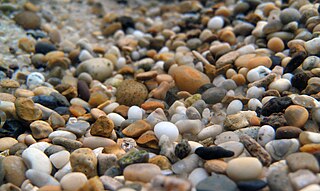
A terrarium is usually a sealable glass container containing soil and plants that can be opened for maintenance to access the plants inside; however, terraria can also be open to the atmosphere. Terraria are often kept as ornamental items.
The Arizona-Sonora Desert Museum is a 98-acre zoo, aquarium, botanical garden, natural history museum, publisher, and art gallery founded in 1952. Located just west of Tucson, Arizona, it features two miles (3.2 km) of walking paths traversing 21 acres of desert landscape. It is one of the most visited attractions in Southern Arizona.

Herpetoculture is the keeping of live reptiles and amphibians in captivity, whether as a hobby or as a commercial breeding operation. "Herps" is an informal term for both reptiles and amphibians, shortened from the scientific umbrella term “herptiles”. It is undertaken by people of all ages and from all walks of life, including career herpetologists, professional reptile or amphibian breeders, and casual hobbyists.

The San Diego Zoo is a zoo in Balboa Park, San Diego, California, housing 4,000 animals of more than 650 species and subspecies on 100 acres (40 ha) of Balboa Park leased from the City of San Diego. Its parent organization, San Diego Zoo Wildlife Alliance, is a private nonprofit conservation organization, and has one of the largest zoological membership associations in the world, with more than 250,000 member households and 130,000 child memberships, representing more than a half million people.

Schönbrunn Zoo is a 17-hectare (42-acre) zoo in the city of Vienna, Austria. Established in 1752, it is the world's oldest zoo still in operation. It is also a UNESCO World Heritage Site, being a part of the Schönbrunn Palace gardens. It generally receives more than 2 million visitors every year.

A paludarium is a type of vivarium that incorporates both terrestrial and aquatic elements. Paludaria usually consist of an enclosed container in which organisms specific to the biome being simulated are kept. They may be maintained for purely aesthetic reasons or for scientific or horticultural purposes. The word 'paludarium' comes from the Latin word 'palus' meaning marsh or swamp and '-arium' which refers to an enclosed container.
Under Tank Heater (UTH), also called heating mat or heating pad, is a heating device created by the pet industry for husbandry of reptiles and amphibians. It is a flat piece of metal and plastic that provides a convenient and easy way to heat your reptiles, amphibian and even aquariums fish tanks. They provide constant heat, allowing you to create the optimal temperature gradient within the nursery

Aquascaping is the craft of arranging aquatic plants, as well as rocks, stones, cavework, or driftwood, in an aesthetically pleasing manner within an aquarium—in effect, gardening under water. Aquascape designs include a number of distinct styles, including the garden-like Dutch style and the Japanese-inspired nature style. Typically, an aquascape houses fish as well as plants, although it is possible to create an aquascape with plants only, or with rockwork or other hardscape and no plants.

Fishkeeping is a popular hobby, practiced by aquarists, concerned with keeping fish in a home aquarium or garden pond. There is also a piscicultural fishkeeping industry, serving as a branch of agriculture.

An oceanarium can be either a marine mammal park, such as Marineland of Canada, or a large-scale aquarium, such as the Lisbon Oceanarium, presenting an ocean habitat with marine animals, especially large ocean dwellers such as sharks.

The substrate of an aquarium refers to the material used on the tank bottom. It can affect water chemistry, filtration, and the well-being of the aquarium's inhabitants, and is also an important part of the aquarium's aesthetic appeal. The appropriate substrate depends on the type of aquarium; the most important parameter is whether the aquarium contains fresh water or saltwater.
SEA LIFE Sydney Aquarium is a public aquarium that features a large variety of Australian aquatic life, displaying more than 700 species comprising more than 13,000 individual fish and other sea and water creatures from most of Australia's water habitats. Opened in 1988, it is regarded as one of Sydney's premier tourist attractions with over 55% of its visitors each year coming from overseas.

A freshwater aquarium is a receptacle that holds one or more freshwater aquatic organisms for decorative, pet-keeping, or research purposes. Modern aquariums are most often made from transparent glass or acrylic glass. Typical inhabitants include fish, plants, amphibians, and invertebrates, such as snails and crustaceans.

The Golfodulcean poison frog or Golfodulcean poison-arrow frog is a species of frog in the family Dendrobatidae endemic to Costa Rica.

Crinum thaianum, also called the Thai onion plant or water onion, is an emergent plant species, endemic to the coastal plain of Ranong and Phang Nga Provinces, Thailand. Its natural habitat is to grow along the banks of flowing, medium- to fast-running streams, where its roots and bulb are submerged in the sediment, while its leaves grow long in the current and can access fresh air at the surface. When in bloom, the flower is an umbel of large, showy blossoms above the waterline. These growth habits make it a wonderful addition for tropical aquaria, and it is sold in many regions to be used specifically for growth within displays of tropical fish. It also serves the added benefit of oxygenating the water and absorbing ammonia, which is toxic to most aquatic animals. In nature, however, the species is threatened with extinction, and diminishing rapidly, due to habitat destruction.

The ZooParc de Beauval, more commonly called Beauval Zoo or, more simply, Beauval, is a French zoological park located in Saint-Aignan-sur-Cher, Centre-Val de Loire. It features more than 35,000 animals on 40 hectares, which is one of the largest animal collections in France and in Europe. Created in 1980 by Françoise Delord, it is now run by her son, Rodolphe Delord, and managed by his family, which owns most of the capital.

An aquarium is a vivarium of any size having at least one transparent side in which aquatic plants or animals are kept and displayed. Fishkeepers use aquaria to keep fish, invertebrates, amphibians, aquatic reptiles, such as turtles, and aquatic plants. The term aquarium, coined by English naturalist Philip Henry Gosse, combines the Latin root aqua, meaning 'water', with the suffix -arium, meaning 'a place for relating to'.

The northern caiman lizard is a species of lizard found in northern South America.
The substrate of a vivarium is the material used on the floor of the enclosure. It can affect humidity levels, filtration as well as the well-being of the inhabitants. The appropriate substrate depends on the type of animal in the enclosure.

A bioactive terrarium is a terrarium for housing one or more terrestrial animal species that includes live plants and populations of small invertebrates and microorganisms to consume and break down the waste products of the primary species. In a functional bioactive terrarium, the waste products will be broken down by these detritivores, reducing or eliminating the need for cage cleaning. Bioactive vivariums are used by zoos and hobbyists to house reptiles and amphibians in an aesthetically pleasing and enriched environment.























